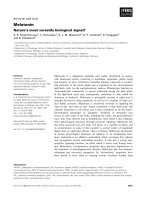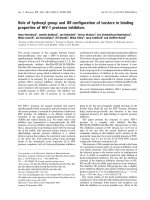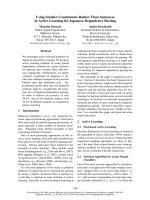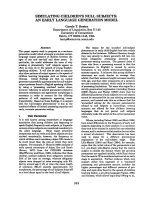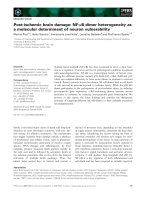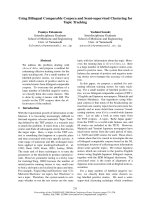báo cáo khoa học: " Using Mitrofanoff’s principle and Monti’s technique as a surgical option for bladder augmentation with a continent stoma: a case report" pps
Bạn đang xem bản rút gọn của tài liệu. Xem và tải ngay bản đầy đủ của tài liệu tại đây (385.5 KB, 3 trang )
CAS E REP O R T Open Access
Using Mitrofanoff’s principle and Monti’s
technique as a surgical option for bladder
augmentation with a continent stoma:
a case report
Marcelo F Cassini
*
, Antonio A Rodrigues Jr, Silvio Tucci Jr, Adauto J Cologna, Rodolfo B Reis, Antonio CP Martins,
Haylton J Suaid
Abstract
Introduction: Hydronephrosis, reflux and renal failure are serious complications that occur in patients with
neurogenic bladder associated with myelomeningocele. When the bladder compliance is lost, it is imperative to
carry out surgery aimed at reducing bladder storage pressure. An ileocystoplasty, and for patients not suitable for
intermittent catheterization, using the Mitrofanoff principle to form a continent stoma and the subsequent closure
of the bladder neck, can be used. We report here, for the first time to the best of our knowledge, an association
between two previously described techniques (the Mitrofanoff principle and the technique of Monti), that can
solve the problem of a short appendix in obese patients.
Case presentation: A 33-year-old male Caucasian patient with myelomeningocele and neurogenic bladder
developed low bladder compliance (4.0 mL/cm H
2
O) while still maintaining normal renal function. A bladder
augmentation (ileocystoplasty) with continent derivation principle (Mitrofanoff) was performed. During surgery, we
found that the patient’s appendix was too short and was insufficient to reach the skin. We decided to make an
association between the Mitrofanoff conduit and the ileal technique of Monti, through which we performed an
anastomosis of the distal stump of the appendix to the bladder (with an antireflux valve). Later, the proximal
stump of the appendix was anastomosed to an ileal segment of 2.0 cm that was open longitudinally and
reconfigured transversally (Monti technique), modeled by a 12-Fr urethral catheter, and finally, the distal stump was
sutured at the patient’s navel.
After the procedure, a suprapubic cystostomy (22 Fr) and a Foley catheter (10 Fr) through the continent conduit
were left in place. The pat ient had recovered well and was discharged on the tenth day after surgery. He rema ined
with the Foley catheter (through the conduit) for 21 days and cystostomy for 30 days. Six months after surgery he
was continent with good bladder compliance without reflux and fully adapted to catheterization through the
navel.
Conclusion: The unpublished association between the Mitrofanoff and Monti techniques is feasible and a very
useful alternative in urologic cases of derivation continent in which the ileocecal appendix is too short to reach the
skin (i.e., in obese patients).
* Correspondence:
Department of Surgery and Anatomy, Division of Urology, Ribeirao Preto
Medical School, Sao Paulo University, Sao Paulo, Brazil
Cassini et al. Journal of Medical Case Reports 2011, 5:49
/>JOURNAL OF MEDICAL
CASE REPORTS
© 2011 Cassini et al; licensee BioMed Central Ltd. This is an Ope n Access article distributed under the terms of the Creative Commons
Attribution License ( which permits unrestricted u se, distribution, and re prod uction in
any medium, provided the or iginal work is properly cited.
Introduction
The development of hydronephrosis, vesicoureteral
reflux and renal scarring with subsequent progression to
renal failure are feared and serious complications that
can occur in patients with neurogenic bladder associated
with myelomeningocele. Such patients should be treated
starting in childhood with clean and intermittent cathe-
terization along with anticholinergics in the presence of
detrusor overactivity. In severe cases (i.e., sphincter
dyssynergia), there are greater risks of renal failure.
When irrespective of the treatment, a patient has an
unsatisfactory development and l oss of bladder compli-
ance, it is imperative to avoid future renal failure by sur-
geries aimed at reducing bladder storage pressure. Our
service routinely uses ileocystoplasty and, for patients
unable or not adapted to intermittent catheterization,
Mitrofanoff’s principle (in which the vascularized ileoce-
cal appendix is anastomosed at the skin and bladder,
with a nonrefluxing valve and continent stoma). We
then proceed with closure of the bladder neck.
Case Presentation
A 33-year-old male Caucasian patient with myelomenin-
gocele and neurogenic bladder had an unsatisfactory
clinical progression despite treatment with intermittent
catheterization and anticholinergics. Not suitable for
catheterization, the patient develop ed low bladder com-
pliance (4.0 mL/cm H
2
O) and grade II left vesicouret-
eral reflux. Although his renal function was still
preserved, bladder augmentation (ileoc ystoplasty) was
indicated.
We used 15 cm of ileum, 20 cm from the ileocecal
valve, that was opened longitudinally and reconfigured
into a “U” shape, with continent derivation (Mitrofan-
off’s principle). During surgery, we found a short ileoce-
cal appendix that wa s insufficient to reach the skin.
Then it was decided to make an association between the
Mitrofanoff’ s principle and the Monti’s technique of
ileal conduit by which we performed an anastomosis of
the distal stump of t he appendix to the bladder with an
antireflux valve. Then, the proximal stump of the appen-
dix was anastomosed to an ileal segment of 2.0 cm that
was open longitudinally and reconfigured transversally
(Monti technique), modeled by a 12-Fr urethral catheter,
and finally, the distal stump was sutured at the patient’s
navel (Figure 1). After the procedure, we left in place a
suprapubic cystostomy (2 2 Fr) and a Foley catheter
(12 Fr) through the continent conduit after bladder neck
closure in two layers using 2.0 Vicryl. The patient recov-
ered well, restarting an early progressive diet and ambu-
lation. He stayed in the hospital for 10 days after
surgery, and the Foley catheter remained for 30 days
(through conduit) and cystostomy by 45 days. At pre-
sent, the patient is continent with good vesical augmen-
tation compliance (35-50 mL/cm H
2
O) and no urethral
reflux, and he is well adapted to intermittent catheteri-
zation of the umbilicus.
Discussion
TheMitrofanoffprinciplefor creation of a continent
catheterizable stoma using the appendix has been a
mainstay in the armamentarium of pediatric urologis ts
Figure 1 Association of Mitrofanoff’s principle and Monti’s technique. Anastomosis of vascularized appendix (right) and ileal conduit (left).
Cassini et al. Journal of Medical Case Reports 2011, 5:49
/>Page 2 of 3
and reconstructive surgeons since it was originally
described in 1980 [1]. This principle involves the use of
a small-caliber tube implanted into a compliant bladder
or reservoir with a nonrefluxing anastomosis to provide
a convenient and effective method of emptying the blad-
der. Applications of this technique have expanded to
include the use of ureter, tapered ileum, stomach, tubu-
larized bladder flaps, and transverse tubularized bowel,
as originally described by Yang [2] and Monti et al [3]
and later modified by Casale [4]. Interest in these other
tissues stems from the occasional lack of a suitable
appendix or, more commonly, the d esire to use the
appendix for the Malone antegrade continent enema
(MACE ) procedure [5]. Alternatives such as the “doubl e
Monti” technique (with two Yang-Monti channels in a
line) can also be use d. Overall, we have achieved better
results in urinary continence when we performed the
antireflux valve with the appendix than the ileum
(Monti). The lack of a suitable appendix may be a more
common problem in adults because the thickness of the
abdominal wall and the pelvic position of the bladder
can make the distance between the skin and bladder too
long to create a tension-free anastomosis. This result is
true if the umbilicus is chosen for the stoma. Especially
in this case, the adipose tissue of the patient’s abdomen
was very thick, and the appendix was t oo short to be
used directly and reach the skin at the right iliac fossa.
Another relevant factor is that the navel’s skin, naturally
already through the abdominal wall, facilitates the ana-
stomosis with the continent conduit, making the
patient’s abdomen more aesthetically pleasing.
An interesting option to solve this problem is related
here. A 2- to 3-cm segment of bowel (usually ileum) is
isolated on its mesentery in the standard fashion. If
simultaneous augmentation or a neobladder creation is
being performed, the Montisegmentshouldbehar-
vested from an adjacent section, eliminating t he need
for an additional bowel anastomosis (see Figure 1). The
segment is then opened longitudinally along the antime-
senteric border and retubularized transversely with
absorbable suture over a 12-Fr catheter. Stay sutures
placed on both ends of the tube facilitate closure by
maintaining tension. The central portion is closed with
a running suture, and the ends are closed with an inter-
rupted suture so adjustments to the length of the chan-
nel at the site of skin (umbilicus) or appendix and
bladder implantation can be made without disrupting
the suture line. An added benefit of the procedure is the
ability to change the position of the mesentery along the
channel by simply changing the location of the initial
longitudinal incision. For instance, an asymmetrically
positioned mesentery is helpful in patients with a large
amount of subcutaneous tissue because channel length
is required to reach the skin and the appendix that is
anastomosed at the bladder wall with a nonrefluxing
anastomosis.
Conclusion
The association of Mitrofanoff’ sprinciplewiththe
Monti procedure is feasible and can be a useful alterna-
tive, especially in obese patients who need a contine nt
stoma (reservoir) and who have an appendix that is too
small to reach the skin.
Consent
Written informed consent was obtained from the patient
for publication of this case report and accompanying
images. A copy of the written consent is available for
review by the Editor-in-Chief of this journal.
Authors’ contributions
MFC wrote the article and was the surgeon of the case. AAR had the idea
and helped with the surgery. ST, AJC and ACPM performed the literature
review. RBR wrote the discussion and literature review. HJS discussed the
case and revised the article. All authors have read and approved the final
manuscript.
Competing interests
The authors declare that they have no competing interests.
Received: 16 January 2010 Accepted: 3 February 2011
Published: 3 February 2011
References
1. Mitrofanoff P: Trans-appendicular continent cystostomy in the
management of the neurogenic bladder [in French]. Chir Pediatr 1980,
21:297-305.
2. Yang WH: Yang needle tunneling technique in creating antireflux and
continent mechanisms. J Urol 1993, 150:830-834.
3. Monti PR, Lara RC, Dutra MA, de Carvalho JR: New techniques for
construction of efferent conduits based on the Mitrofanoff principle.
Urology 1997, 49:112-115.
4. Casale AJ: A long continent ileovesicostomy using a single piece of
bowel. J Urol 1999, 162:1743-1745.
5. Malone PS, Ransley PG, Kiely EM: Preliminary report: the antegrade
continence enema. Lancet 1990, 336:1217-1218.
doi:10.1186/1752-1947-5-49
Cite this article as: Cassini et al.: Using Mitrofanoff’s principle and
Monti’s technique as a surgical option for bladder augmentation with a
continent stoma: a case report. Journal of Medical Case Reports 2011 5:49.
Submit your next manuscript to BioMed Central
and take full advantage of:
• Convenient online submission
• Thorough peer review
• No space constraints or color figure charges
• Immediate publication on acceptance
• Inclusion in PubMed, CAS, Scopus and Google Scholar
• Research which is freely available for redistribution
Submit your manuscript at
www.biomedcentral.com/submit
Cassini et al. Journal of Medical Case Reports 2011, 5:49
/>Page 3 of 3

